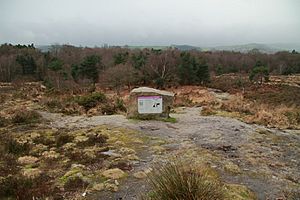Bovey Heath facts for kids
Bovey Heath is a special natural area in south Devon, England. It's about the size of 60 football fields (32 hectares or 50 acres). This land is mostly a type of open countryside called heathland.
Even though it's mostly heathland, Bovey Heath also has some wet oak forests. It's a home for many rare animals and plants. You might find birds like the Dartford warbler, stonechat, and nightjar here. A special insect, the narrow headed ant, also lives on the heath.
Because of its unique nature, Bovey Heath has been protected for a long time. It became a Site of Special Scientific Interest (SSSI) in 1989. This means it's a place the government wants to keep safe for its wildlife and geology. Later, in 2002, the Devon Wildlife Trust started looking after it as a nature reserve. In 2003, it was also named a Local Nature Reserve.
Contents
History of Bovey Heath
How Bovey Heath Was Formed
Bovey Heath probably started to look like it does today about 4,000 years ago. This was during the Bronze Age. Farmers back then would clear parts of the forest to make space for their animals to graze and to grow crops. This clearing helped create the open heathland we see now. There's even an old burial mound, called a tumulus, from the Bronze Age on the site.
The Battle of Bovey Heath
A very important battle happened here during the English Civil War. This war was fought between the King's supporters and Parliament's supporters. The battle at Bovey Heath took place on January 9, 1646. It was a big moment for the South West of England.
You can still find one of only two earthworks (old defensive walls made of earth) from this war in the South West right here. This earthwork is a Scheduled Ancient Monument, which means it's a very important historical site that is protected.
Changes Over Time
Long ago, Bovey Heath was much bigger, covering over 380 hectares (1,000 acres). But in the 1800s and 1900s, a lot of the heath was dug up. People were mining for a special type of clay called ball clay.
During the Second World War, and for a short time after, American soldiers used the heath as a training ground. After the war, the remaining heath was not looked after very well. People used it as a place to dump rubbish and for illegal off-road motorbike riding. Luckily, when the Devon Wildlife Trust took over, they stopped these harmful activities and started protecting the heath.


